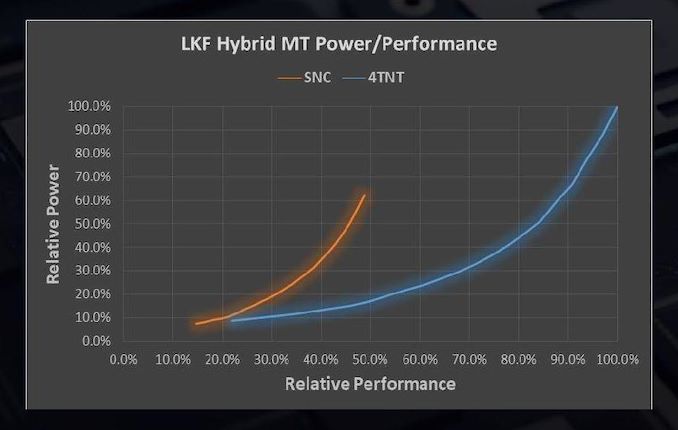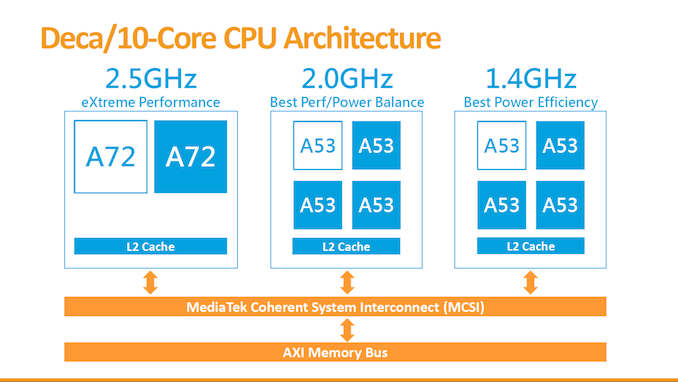The Intel Lakefield Deep Dive: Everything To Know About the First x86 Hybrid CPU
by Dr. Ian Cutress on July 2, 2020 9:00 AM ESTHow To Treat a 1+4 Hybrid CPU
At the top of the article, I explained that the reason for using two different types of processor core, one big on performance and the other big on efficiency, was that users could get the best of both worlds depending on if a workload could be run efficiently in the background, or needed the high performance for a user experience interaction. You may have caught onto the fact that I also stated that because Intel is using a 1+4 design, it actually makes more sense for multi-threaded workloads to run on the four Atom cores.
Using a similar power/performance graphs, the effect of having a 1+4 design is quite substantial. On the left is the single core power/performance graphs, but on the right is when we compare 1 Sunny Cove to all 4 Tremont cores working together.
Where the previous graph considered a 1+1 design, which is more relevant in those user experience scenarios listed above, on the right is the 1+4 design for when the user demands a heavier workload that might not be latency critical. Because there are four Atom cores, the blue line multiplies by four in both directions.
Now obviously the real world scenario is somewhere between the two, as it is possible to use only one, two, or three of the smaller cores at any given time. The CPU and the OS is expected to know this, so it can govern when workloads that can be split across multiple cores end up on either the big core or the small core.
In this graph from Intel, we have three distinct modes on which threads can operate.
- ‘Sunny Cove/SNC’ is for responsiveness and user experience threads,
- ‘Tremont/TNT Foreground’, for user related tasks that require multiple threads that the user is waiting on.
- ‘Tremont/TNT Background’, for non-user related tasks run in efficiency mode
Even though the example here is web browsing, it might be best to consider something a bit beefier, like video encoding.
If we run video encoding, because it is a user related task that requires multiple threads, it will run on the four Tremont cores (TNT FG). Anything that Windows wants to do alongside that gets scheduled as TNT BG. If we then open up the start menu, because that is a responsiveness task, that gets scheduled on the SNC core.
Is 1+4 the Correct Configuration?
Intel here has implemented a 1+4 core design, however in the smartphone space, things are seen a little differently. The most popular configuration, by far, is a 4+4 design, simply because a lot of smartphone code is written to take advantage of multiple foreground or multiple background threads. There are a number of cost-down designs that reduce die area and power by going for a 2+4 implementation. Everyone seems adamant that 4 is a good number for the smaller cores, partly because they are small and cheap to add, but because Arm’s quad-core implementation is a base unit for its IP.
The smartphone space in recent quarters has also evolved from a two tier system of cores. In some of the more leading edge designs, we now have three types of core: a big, a middle, and a small. Because of the tendency to stay with eight core designs, we now get 1+3+4 or 2+2+4 designs, powered by complex schedulers that manage where to put the threads for the best user experience, the best battery life, or somewhere in the middle. Mediatek has been famously dabbling in 10 core designs, going for a 2+4+4 approach.
One thing missing from all of these implementations is an SoC with one big core and four small cores. Smartphone vendors don’t seem to be interested in 1+4 silicon, and yet Intel has decided on it for Lakefield. This is borne out of decisions made on both sides.
From the smartphone perspective, when hybrid designs came about, the big cores just weren’t powerful enough on their own. In order to offer something more than simply basic, at least two cores were needed, but because of how Arm architected the big and little designs, it almost became standard to look into 4+4 implementations of big and small cores. It was only until this configuration was popularized over a couple of years, and Arm big cores got more powerful, that chip designs started looking at 2+4, or 1+3+4 designs.
On Intel’s side of the fence, the biggest problem it has is the size of the Sunny Cove core. By comparison, it’s really, really big. Because the graphics core is the same as Ice Lake and reuses its design, there simply isn’t enough room within the 82 mm2 compute die to add another core. Not only that, but there is a question of power. Sunny Cove wasn’t built for sub-1W operation, even in the Tremont design. We see big smartphone silicon pulling 4-5W when all eight cores are active – there is no way, based on our understanding of Intel’s designs, that we could see four (or even two) Sunny Cove cores being in the optimal performance per watt range while being that low. Intel’s Lakefield graphics, with 64 EUs, is running at only 500 MHz – a lot lower than the Ice Lake designs. Even if Intel moved that down to a 32 EU design to make space for another Sunny Cove core, I reckon that it would eat the power budget for breakfast and then some.
Intel has made the 1+4 design to act as a 0+4 design that sometimes has access to a higher performance mode. Whereas smartphone chips are designed for all eight cores to power on for sustained periods, Lakefield is built only for 0+4 sustained workloads. And that might ultimately be its downfall. This leads onto a deep discussion about Lakefield’s performance, and what we should expect from it.














221 Comments
View All Comments
serendip - Thursday, July 2, 2020 - link
The ARM MacOS devices could be mobile powerhouses at (gasp!) equal price points as Windows devices running either ARM or x86. Imagine a $1000 Macbook A13 or A14 with double the performance than a Surface Pro X or Galaxy Book S costing the same.lmcd - Friday, July 3, 2020 - link
Considering the hurdles just to use any form of open source software with the platform, they're not equal.JayNor - Thursday, July 2, 2020 - link
Intel already makes LTE modems. By chiplet, I am referring to the Foveros 3D stackable chiplets in this case ... Intel also makes emib stitched chiplet form features for their FPGAs. So, not just a marketing term. These have to implement certain bus interfaces or TSV placement requirements to work with the FPGA or Foveros manufacturing.henryiv - Thursday, July 2, 2020 - link
What a shame to disable AVX-512. The circuitry is probably left there to support SSE, which is still a common denominator with Tremont cores. Also, 5 cores not running together is a huge huge bummer.This first generation is an experimental product and is to be avoided. In the next generation, the Tremont successor will probably get at least 256-bit AVX support, which will be finally possible to use across 5 cores. Transition to 7nm should also give the elbow room needed to run all 5 cores at the same time at full throttle within the limited 7w power budget.
jeremyshaw - Thursday, July 2, 2020 - link
By the usual Intel Atom timeline, it will be 2023 before a Tremont successor comes out. By then, will anyone even care about Intel releases anymore?lmcd - Thursday, July 2, 2020 - link
Bad joke, right? Intel is signaling that Atom is moving to the center of their business model. Previous times Intel prioritized Atom, Atom got every-other-year updates. I'd expect a 2022 core or sooner, if you assume Tremont was "ready" in 2019 but had no products (given 10nm delays and priority to Ice Lake).serendip - Friday, July 3, 2020 - link
Moving Atom to the center of their business model? Atom is still being treated as an also-ran.Intel now has to contend with a resurgent AMD gobbling up x86 market share in multiple segments and ARM encroaching on consumer and server segments. Putting Atom as a priority product would be suicidal.
Lucky Stripes 99 - Saturday, July 4, 2020 - link
Not really. The ARM big/little design has been fairly successful. Most likely is that you'll see the walls between Atom and Core break down a bit in order to keep code optimizations happy on either core type.Deicidium369 - Saturday, July 4, 2020 - link
revenues show they are gobbling up nothing.Namisecond - Saturday, July 11, 2020 - link
There is a limit to the amount of market share AMD can gobble up and they are currently at or near their limit. AMD is production limited and always will be.